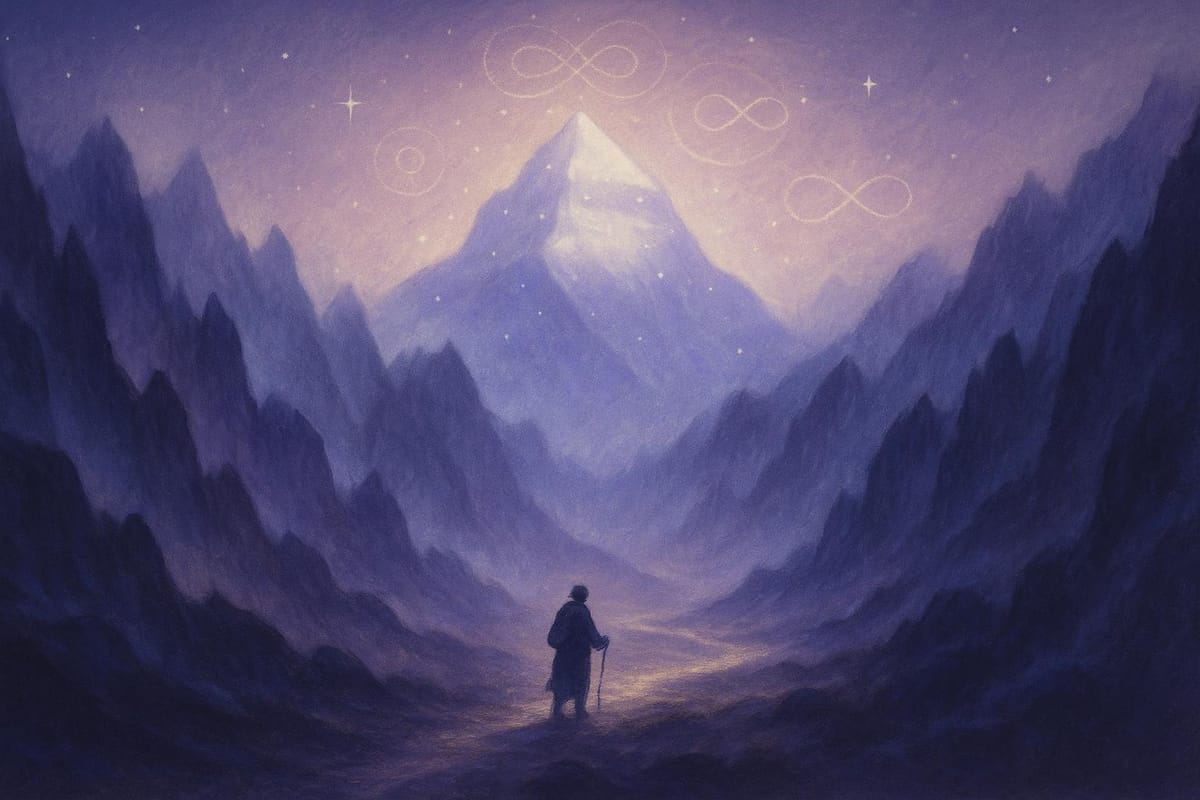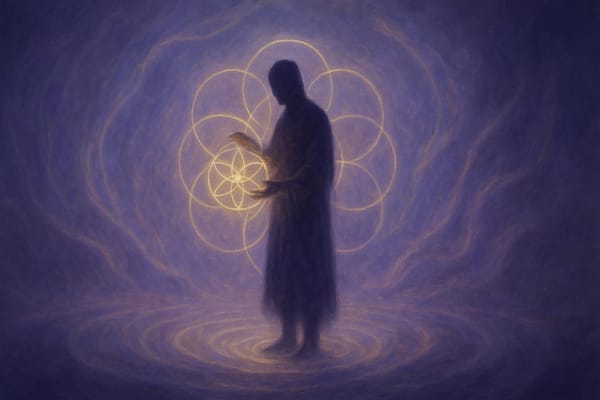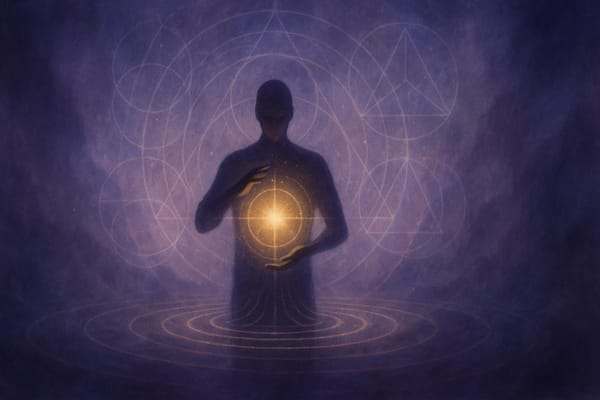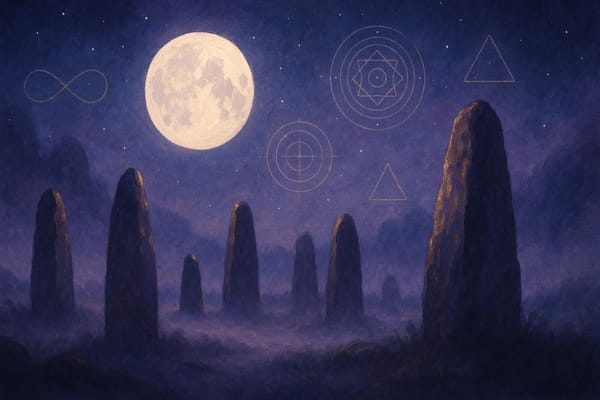Walking Mount Kailash Kora: Walking the Axis Mundi of the World's Spiritual Geography
Explore the spiritual journey of the Mount Kailash Kora, a transformative trek that connects the physical and spiritual realms.

Mount Kailash, located in Tibet, stands at 6,638 meters (21,778 feet) and holds sacred significance for Hindus, Buddhists, Jains, and followers of the Bon tradition.
The Mount Kailash Kora is a 32-mile (52-kilometer) trek around the mountain, believed to cleanse negative karma, offer spiritual transformation, and bring clarity to those who complete it.
Here’s a quick overview of the key points:
- Why It’s Sacred: Revered as the axis mundi (a cosmic link between heaven and earth), Mount Kailash is considered the home of Lord Shiva (Hinduism), Mount Meru (Buddhism), Ashtapada (Jainism), and the nine-story Swastika Mountain (Bon tradition).
- The Trek: The Kora takes about three days to complete, with its highest point at Dolma La Pass (18,471 feet). The journey is physically demanding but spiritually rewarding.
- Spiritual Beliefs: Walking the Kora is thought to purify sins, break the cycle of rebirth, and offer profound personal growth.
- Preparation: Physical training, altitude acclimatization, and spiritual intention-setting are essential.
- When to Go: The best time is from April to mid-October, with September offering stable weather.
Key Landmarks:
- Yam Dwar: Symbolizes spiritual renewal.
- Dirapuk Monastery: A place for rest and reflection.
- Dolma La Pass: The spiritual and physical high point of the trek.
- Zutulupuk Monastery: Inspires introspection and clarity.
Walking the Mount Kailash Kora is more than a trek - it’s a journey of spiritual discovery and transformation that challenges the body and nurtures the soul.
Kailash Parikrama, Mt. Kailash Kora Trek - How to go Kailash Yatra via Yamdwar in 2025, Guide, Video
The Spiritual and Symbolic Meaning of Mount Kailash
Mount Kailash is often regarded as one of the most spiritually profound places on Earth. Its significance goes far beyond its physical presence, touching on deep aspects of human spirituality and consciousness. This sacred mountain serves as a bridge between ancient traditions and modern interpretations, blending the mysteries of sacred geometry with its revered status across various spiritual paths.
Sacred Geometry and Energy Vortices
Mount Kailash’s striking pyramid-like shape, with its four faces perfectly aligned to the cardinal directions, is often described as a natural mandala that radiates powerful energy fields.
Interestingly, the distances between Mount Kailash and other sacred landmarks seem to follow a pattern. For example, Stonehenge lies exactly 6,666 kilometers away, while the South Pole is 13,332 kilometers distant. Some view these measurements as evidence of an intentional sacred alignment.
Russian researchers have explored theories suggesting that Mount Kailash might have functioned as an ancient energy generator, pointing to its resemblance to pyramidal structures around the world. Its unique formation, shaped by millions of years of geological uplift and erosion, has led many to associate it with the principles of sacred geometry.
These energy dynamics are believed to enhance the profound physical and spiritual experiences that pilgrims report during the kora, the sacred circumambulation of the mountain.
Mount Kailash Across Different Traditions
Mount Kailash holds a central place in several spiritual traditions, each offering its own interpretation of its sacred importance. Here’s a look at how it is revered across different belief systems:
| Tradition | Sacred Name/Concept | Spiritual Significance |
|---|---|---|
| Hinduism | Abode of Lord Shiva | Believed to be the eternal home of Lord Shiva |
| Buddhism | Mount Meru/Demchok's Realm | Considered the domain of Demchok, the Buddha of supreme bliss |
| Jainism | Ashtapada | The site where Rishabhadeva, the first Tirthankara, attained enlightenment |
| Bon | Cosmological Axis | Seen as the spiritual center of the world |
These shared beliefs have fostered a mutual respect among these traditions, leading to a collective decision to prohibit climbing Mount Kailash, ensuring its sacredness remains intact.
"Mount Kailash is one of the few peaks in the world that has never been summited." – Real2Real
Beyond its religious and cultural significance, Mount Kailash also challenges our understanding of time and space, offering profound spiritual insights.
Axis Mundi and Timeline Collapse
Mount Kailash is often described as the axis mundi - a cosmic link between heaven and Earth. This concept transcends religious boundaries, resonating with spiritual practitioners who report transformative experiences during their pilgrimage.
Many describe phenomena such as heightened awareness, ancestral memory recall, and a sense of collapsing timelines.
Scientific research, including studies by Russian and American experts, supports the idea that Mount Kailash occupies a central role in the Earth's energy network. Some even suggest it may act as a gateway to other dimensions, far beyond its geographical significance.
Pilgrims frequently recount experiencing what they call "spiritual downloads" - sudden bursts of insight or knowledge that seem to come from beyond the physical realm. These encounters often include:
- Ancestral memory activation: A sudden connection to inherited wisdom or experiences.
- Timeline perception shifts: Moments where the boundaries between past, present, and future blur.
- Dimensional awareness: A sensation of coexisting realities beyond the physical world.
- Karmic pattern recognition: Deep clarity about recurring life challenges and their spiritual meaning.
Walking the kora often feels like stepping out of linear time and into a space governed by spiritual principles. This shift can lead to rapid inner transformation, offering pilgrims a chance to reflect on karmic patterns and gain new perspectives. For many, the journey is as much about spiritual growth as it is about physical endurance, making it a profoundly life-changing experience.
How to Prepare for the Mount Kailash Kora
Getting ready for the Mount Kailash Kora is no small task. This sacred 32-mile trek, set at extreme altitudes, requires careful preparation - physically, spiritually, and practically. Starting your prep at least three months before your journey will set you up for a safer and more meaningful experience.
Physical Preparation: Building Strength and Endurance
The physical challenges of the Mount Kailash Kora are intense, with high altitudes amplifying the difficulty. Nearly half of all pilgrims experience altitude sickness, so proper training is crucial.
Start with Endurance Training
Begin by assessing your fitness level. Walk 3–6 miles and pay attention to how your body feels. Incorporate brisk walking or cycling for 20–30 minutes to test your cardiovascular endurance.
Gradually increase the intensity of your workouts over three months. Start with 15–20 minute sessions of jogging, swimming, or long walks, and work up to one-hour sessions. This progression will help your heart and lungs adapt to sustained physical activity.
Strengthen Key Muscle Groups
Exercises like squats, lunges, and calf raises are perfect for building leg strength, which you'll need for trekking over uneven terrain. Add planks, push-ups, and light weightlifting to build core and upper body strength - this will help you carry your gear and handle the physical demands of the trail.
Prepare for Altitude
If possible, spend time hiking at elevations between 8,000–10,000 feet. Even a few short trips to higher altitudes can help your body start adjusting by increasing red blood cell production. During these practice hikes, limit your daily altitude gains to allow for proper acclimatisation.
Boost Lung Capacity
Breathing exercises like Kapalabhati and Anulom Vilom can improve your lung capacity and oxygen efficiency. These techniques are particularly helpful in high-altitude conditions where oxygen levels are lower.
Improve Flexibility and Balance
Yoga can be a great addition to your routine. Poses like Trikonasana (Triangle Pose) and Tadasana (Mountain Pose) not only improve flexibility and balance but also help you connect with the spiritual aspect of the journey.
"Being touched by this energy, being touched by this grace, being touched by the power of what is there at Kailash can transform a human being forever."
– Sadhguru Jaggi Vasudev
Spiritual Preparation: Aligning Your Intentions
While physical readiness is vital, preparing your mind and spirit is equally important. The journey to Mount Kailash is deeply spiritual, and aligning your inner self with the energy of the mountain can make the experience profoundly meaningful.
Set Clear Intentions
Focus on how you want to feel during and after the journey, rather than specific outcomes. For example, instead of saying, "I want to fix my problems", try affirming, "I am open to finding clarity and peace." Write down your intentions and keep them visible so they can guide you as you prepare.
Establish Simple Rituals
Create rituals that help you connect with your intentions. This could be as simple as lighting a candle while reflecting on your goals or reciting affirmations each morning. These small acts can add a sense of purpose and commitment to your preparations.
"Where attention goes, energy flows. Where intention goes, energy flows."
– James Redfield
Incorporate Intentions Into Daily Life
Bring your intentions into your everyday routine through morning affirmations, mindful moments throughout the day, and evening journaling. Trust the process and remain open to the insights the journey might bring.
Practical Planning for the Journey
The logistical side of the Mount Kailash Kora is just as important as the physical and spiritual preparation. Start planning at least a month in advance to ensure you have everything you need.
Permits and Documentation
Traveling to Mount Kailash requires multiple permits, including a Chinese visa, Tibet Travel Permit, Alien's Travel Permit, Military Permit, and Foreign Affairs Permit. Working with a reliable tour company can simplify this process. Permit costs typically range from $72 to $122, with Tibet Travel Permits costing between $50 and $100, and the remaining permits adding about $22.
Best Time to Go
The pilgrimage season runs from April through mid-October. September is particularly popular due to its stable weather, but summer months can bring monsoon rains. Expect temperatures to vary widely, from 32°F to 68°F, so pack accordingly.
Gear Essentials
Bring layered clothing to handle the temperature swings, a small medical kit with altitude sickness medication, and other personal items. Since credit cards are rarely accepted in the Kailash region, carry enough Chinese Yuan for your expenses.
Consider Hiring Support
Hiring porters, horses, or yaks can lighten your load and make the trek more manageable. Here’s a breakdown of common support options and their costs:
| Support Option | Daily Rate (USD) | Best For |
|---|---|---|
| Porter | $48 | Carrying personal gear |
| Horse | $60 | Riding during tough sections |
| Horseman | $55 | Caring for horses |
| Yak (minimum 2) | $49 each | Transporting heavy equipment |
| Yak Herder | $55 | Managing yaks |
Walking the Kora: The Journey Through Different Realities
The 32-mile trek around Mount Kailash, known as the Kora, is more than just a hike - it's a journey that intertwines the physical and the spiritual. This ancient pilgrimage offers travelers a chance to connect deeply with sacred landscapes while undergoing personal transformation.
Key Landmarks and Their Spiritual Significance
As you step onto the clockwise path of the Kora, each landmark reveals a layer of meaning that has resonated with pilgrims for centuries.
Yam Dwar
The journey begins at Yam Dwar, often called the "Gateway of the God of Death." This symbolic starting point represents leaving behind old habits and stepping into spiritual renewal.
Dirapuk Monastery
Dirapuk Monastery provides a place for rest and quiet reflection. Surrounded by breathtaking views, it invites pilgrims to pause and meditate on their path so far.
Dolma La Pass
Standing at a staggering 18,471 feet, Dolma La Pass is both the physical and spiritual high point of the Kora. This sacred peak is often seen as a symbol of personal transformation, where many pilgrims report profound emotional and spiritual breakthroughs.
"The Kailash Yatra tested my limits, but reaching the Dolma La Pass was an emotional and spiritual high point. It felt like a rebirth. The journey was not just about the physical trek but also about connecting with my inner self and finding peace and clarity." – Ravi
Zutulupuk Monastery
As the final monastery on the route, Zutulupuk is a place of deep introspection. Many pilgrims find that this stop inspires moments of clarity and personal insight.
Spiritual Experiences Along the Kora
The Kora is said to cleanse negative karma, and many who undertake it describe experiencing powerful emotional releases. Time itself often feels different on this journey, with moments where past, present, and future seem to blur together. These experiences can bring unexpected clarity about one's life purpose.
"Completing the Kora in Kailash was a life-changing experience. The physical challenge was immense, but the spiritual fulfillment made every step worthwhile." – Srinivasan
Chanting prayers and mantras along the way enhances the meditative aspect of the trek. Some pilgrims even believe that completing the Kora during a full moon magnifies its spiritual energy.
Facing the Physical and Energetic Challenges
The Kora is not without its difficulties. It demands both physical endurance and emotional resilience, but these challenges are an essential part of its transformative power.
Altitude and Physical Strain
The trail reaches its highest point at Dolma La Pass, where the thin air and steep terrain push the body to its limits. With daily treks lasting 6–7 hours, pacing yourself and staying hydrated are essential for managing the physical demands and keeping your mind open to the experience.
Energetic Shifts
Many pilgrims report sudden bursts of emotional or physical energy, often attributed to the mountain's spiritual presence. These shifts can feel intense but are part of the process. Taking breaks and allowing these sensations to settle is key to integrating the experience.
Mental and Emotional Strength
The combination of physical strain and deep self-reflection can bring unresolved emotions to the surface. Practicing mindfulness and meditation along the way can help maintain focus and clarity. When difficult emotions arise, slow, intentional breathing can help you navigate these moments of healing.
The Kora is a journey that merges the outer trek with inner exploration. It’s a continuation of the preparation you’ve undertaken and a path toward lasting transformation, extending far beyond the physical trail.
After the Kora: Processing and Integration
Completing the Mount Kailash Kora marks the beginning of a profound phase of reflection and transformation. As the Dalai Lama wisely noted, "Purpose of a pilgrimage is to engage in transformation; if one comes home the same as they left, it was not worth the time or money." This is where the physical journey transitions into lasting inner growth.
Shifts in Karma and Consciousness
Many pilgrims describe experiencing shifts in their awareness and a sense of karmic release after completing the Kora. These changes can show up in subtle yet profound ways - like sharper intuition, better clarity in decision-making, or a renewed sense of purpose. However, this process isn’t always smooth. It may bring unresolved emotions or strained relationships to the surface, acting as a kind of purification that clears the way for deeper personal growth.
Practices to Stay Grounded and Reflect
To integrate the lessons of the Kora into your everyday life, it’s helpful to establish grounding rituals. Simple practices like chanting a mantra, lighting a candle, or meditating for a few minutes each day can help you stay connected to the energy of the mountain and the insights gained during your pilgrimage.
Journaling can also be a powerful tool. Writing about your experiences or revisiting mental images of sacred sites helps to clear emotional and mental clutter, reinforcing the wisdom you’ve gained. Adding a gratitude practice - whether through daily reflection or small acts of kindness - can further solidify the positive changes sparked by your journey.
"To integrate a mental state is to successfully 'absorb' it, meaning, you can now move on to other matters without suffering the energy drain that comes from 'unfinished business'."
A Lifelong Journey of Transformation
The transformation sparked by the Kora doesn’t stop when the pilgrimage ends. Your ongoing practices not only deepen your personal growth but also contribute to healing the collective wounds of society. As Brother Thomas puts it, "Because of the many societal ills, our nature has been wounded... Therefore, the contemplative life serves as a remedy, an antidote to these afflictions."
Many pilgrims find that their journey strengthens their understanding of interdependence and their connection to others. As Brother Thomas reminds us, "We are all interdependent, we need each other, and we cannot evolve on our own." The energy of the pilgrimage continues to guide and inspire, serving as a lasting reminder of the insights gained along the sacred trail.
Conclusion: The Mount Kailash Kora as a Sacred Path
The Mount Kailash Kora is far more than just a trek - it’s a deeply spiritual journey that intertwines physical effort with personal growth. Spanning 52 kilometers (32 miles), this ancient pilgrimage around Mount Kailash challenges the body while nurturing the soul. For thousands of seekers each year, it’s not just about the breathtaking Himalayan scenery; it’s about embarking on a path of inner transformation. This blend of physical endurance and spiritual awakening encapsulates the essence of the experiences shared earlier.
What truly sets the Kora apart is its significance across various spiritual traditions. Mount Kailash is revered as a place of immense sacred energy, believed to cleanse negative karma and open the mind to higher states of consciousness. This universal reverence cements its status as the axis mundi - a spiritual center where heaven, earth, and the transcendent converge.
The trek’s challenges, particularly at Dolma La Pass, which rises to an altitude of 18,536 feet, push pilgrims to their limits. Yet, it’s within these moments of exhaustion and struggle that many find clarity and connection.
The mountain seems to strip away the superficial, leaving behind a profound sense of purpose and a deeper bond with the divine. Many pilgrims describe the experience as one of overwhelming peace and renewed energy, sparking lasting personal transformation.
The Kora’s true power lies in its ability to transcend the ordinary. Each step offers more than physical progress - it builds spiritual merit, clears past burdens, and fosters insight.
For those navigating the complexities of modern life, the Mount Kailash Kora provides a rare opportunity to step away from the noise and engage in a journey of both self-discovery and community. It’s a space where lasting connections are formed, and what truly matters in life becomes clearer.
In every sense, the Mount Kailash Kora remains a sacred journey - a bridge between the earthly and the divine, offering an experience that resonates deeply with all who undertake it.
FAQs
How should I prepare spiritually for walking the Mount Kailash Kora?
Preparing Spiritually for the Mount Kailash Kora
Getting ready for the Mount Kailash Kora isn’t just about physical preparation; it’s also about nurturing your spiritual side. Start by making meditation a regular part of your day. This practice can help calm your mind and foster a sense of inner peace, setting the tone for your journey.
Adding the chanting of sacred mantras or prayers to your routine can deepen your connection to the mountain's divine energy. Take time to reflect on your intentions for the pilgrimage and work on letting go of negative thoughts or attachments that might weigh you down.
Before setting out, consider seeking blessings or guidance from spiritual mentors or deities connected with Mount Kailash. Approaching the kora with a humble and respectful mindset is just as important. Recognizing the sacredness of this site and its profound cultural meaning will not only honor its significance but will also enrich your entire experience, both physically and spiritually.
What makes the Mount Kailash Kora unique compared to other spiritual pilgrimages?
The Mount Kailash Kora: A Test of Body and Spirit
The Mount Kailash Kora is often regarded as one of the most challenging pilgrimages on the planet - both physically and spiritually. Covering about 32 miles (52 kilometers), this trek takes participants to dizzying heights of over 19,000 feet.
At these altitudes, the air grows thin, increasing the risk of altitude sickness, while the rugged, uneven terrain demands immense physical stamina. Yet, these very hardships are what many believe make the journey so spiritually rewarding. For pilgrims, the Kora is not just a physical challenge but a path to clear karma and connect with the mountain's sacred energy.
What sets the Kora apart from other well-known pilgrimages, like the Camino de Santiago, is its sheer intensity. While the Camino offers more accessible routes and lower altitudes, the Kora pushes participants to their absolute limits. This grueling journey doesn’t just test the body - it transforms the soul, blending extreme physical effort with a deeply personal, spiritual awakening.
What spiritual and personal insights do pilgrims often gain from completing the Mount Kailash Kora?
Pilgrims who take on the Mount Kailash Kora often describe it as an experience that stays with them forever. Many say the journey brings a deep sense of spiritual renewal, as it's believed to cleanse negative karma and encourage personal growth.
This sacred trek is often viewed as a connection point between the physical world and the divine, giving participants a rare chance for reflection and spiritual connection.
The experience can be incredibly emotional. Pilgrims often talk about moments of release, heightened awareness, and a stronger feeling of unity with the universe.
Some even share stories of vivid dreams or visions during or after the journey, which they interpret as spiritual messages or guidance from ancestors. For most, the Kora is much more than a physical trek - it's a profound journey that touches the soul.




